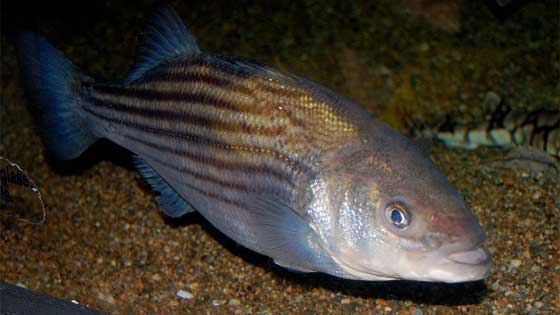Striped Bass Features and Size Facts

Distinguishing features
Color: The striped bass is dark olive green with a bluish tinge. It’s pale on it’s sides and has a silver belly.
The eye has a golden color, which provides good contrast to it silvery body. Most other freshwater bass, members of the sunfish family, usually have a red eye.
Stripes: The sides are barred with 7 or 8 narrow, sooty, longitudinal stripes. The highest stripe is the most distinct.
The dorsal, caudal and anal fins are somewhat dusky.
The striped bass’ upper jaw bones are not sheathed by the pre-orbital bone, which separates it from all the weak fish tribe.
Length ratio: It’s trunk is 4 times as long as it is deep. It’s thick through and the back is hardly arched.
The young Striped Bass are more slender than the old Stripers.
Striped Bass Record
These are large fish.
50lb striped bass are common with the striped bass record weighing 125 lbs/57 kgs and 6 feet long. It was caught off the North Carolina coast in 1891.
However, the average expected size is between 5 to 10 pounds.
- The largest bass are most often female as the females grow larger than males.
In Texas stripers in excess of 50 pounds (23 kgs) have been landed. Although specimens exceeding 100 pounds/45 kg have been caught in saltwater.
- To date, a 67.5-pounder/30.6 kgs was the largest striped bass reported from inland waters.
Using the following guide, it’s possible to estimate the weight of a striped bass to within 10 pounds/4.5 kg.
| Weight (lbs) | Length (inches) |
| 1 | 12-13 |
| 3 | 18-20 |
| 5 | 24 |
| 10-15 | 30-32 |
| 18-20 | 36 |
| 30 | 43 |
| 40 | 47 |
| 50 | 50 |
Striped bass have a deep and keel-less caudal peduncle, stout body, a long head and the presence of 2 well-developed dorsal fins. The 2 dorsal fins are equal in length.
The first fin has 9 or 10 stiff spines in a triangular outline. It originates over the middle of the pectorals.
The second dorsal fin has 12 or 13 soft rays that are regularly graduated in height from front to rear and separated from the first by a distinct space.
It doesn’t have a dorsal or anal finlets and it’s tail is modestly forked. Striped Bass’ anal fin has 3 spines and is as long as the second dorsal fin.
It has 2 spines on the margin of each gill cover and an oblique mouth gaping back to the eye with a moderately pointed nose and a projecting lower jaw.



